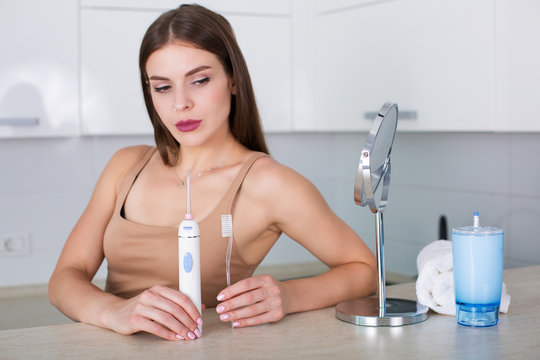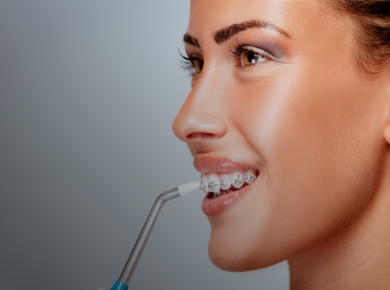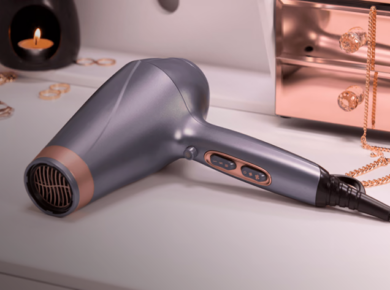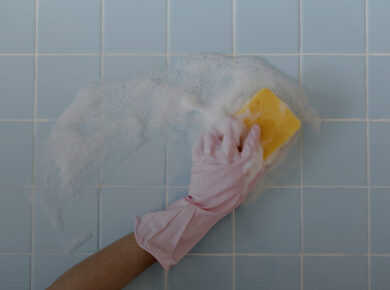The irrigator is a cool additional tool for personal hygiene and the health of your oral cavity. Using a waterpik will strengthen your dental arsenal to avoid caries and daily care. Regular practice of the waterpik is the ground rule to dental health. High efficiency is conditioned to the presence of a wide range of individual nozzles, several operating programs and the ability to dose special liquids for an even steeper cleansing.
The oral cavity is an ideal environment for the formation and growth of microbial biofilm. Plaque, a type of bacterial biofilm, is made up of a variety of bacteria found on the surface of the teeth and soft tissues of the gums, tongue, and inside of the cheeks of the mouth, and contributes to a number of dental illnesses. To save oral health, plaque biofilm must be removed. The most common ways to remove plaque are by brushing and flossing. Another way is oral irrigation.

While toothbrushing is practiced habitually and regularly by most people, flossing is utilized less frequently and not always correctly. In the meantime, valid and handy methods are needed to heighten the level of interdental cleaning.
An oral irrigator is a method that can effectively remove plaque and is easy to use. A lot of useful information about these devices, their application and options can be found in the article “What is an irrigator”.
Now let’s figure out what exactly the irrigator is useful for? What are the benefits of tooth irrigation with a special gadget?
Benefits of use
Dental irrigation is well tolerated for people with diabetes and dental implants, as well as for patients with orthodontic appliances.
- Gentle cleansing in the prevention and treatment of periodontal disease
Periodontal prevention and treatment measures usually focus on removing subgingival plaque to restore healthy oral flora. Medical treatments include root polishing, scaling, and topical or systemic antibiotic regimens designed to kill microbes and stimulate flora resurrection. People with periodontal disease may have difficulty flossing due to bone loss and associated architectural problems. In this instance, a more gentle method is requisite and the mouth irrigation can help out, thanks to its ability to penetrate deep into the pocket and destroy bacteria.
Oral irrigation delivers an aqueous solution for flushing through pulsating water discharges. This method of cleaning has the potential to help maintain the bacterial reduction achieved during medical procedures such as root polishing.

In addition, the choice of this method of cleaning the oral cavity during the course of supporting periodontal procedures can reduce bleeding and inflammation. It should also be noted that efficacy can be increased by adding antimicrobial agents that are commonly used for periodontal maintenance therapy.
- Acceptable for users with orthodontic appliances
People with orthodontic appliances in place face many challenges in progress of plaque removal. These dental accessories trap food bits, potentially increasing the amount of germs in your mouth.
At the same moment, the usage of dental floss to purify the narrow passages between the teeth is often impossible caused to the design features of orthodontic appliances. A waterpik with a specialized orthodontic tip, used after manual toothbrushing, is the most suitable option in this situation.
- Comfortable for diabetics
People diagnosed with diabetes are at potential risk of developing periodontal disease. This is especially true for people who do not have regular monitoring of glucose levels. Oral irrigation with an irrigator is a supportive measure for gentle cleaning of the teeth in order to reduce the amount of plaque and the development or aggravation of dental diseases.
- Recommended for people with dental implants
For the success of the installation of dental implants, it is necessary to preserve and maintain all tissues of the oral cavity healthy. The risk in implant survival increases critically when biofilm accumulates and causes inflammation of the soft tissues surrounding the implants. It can be difficult for a toothbrush and floss to maneuver around implant-supported dentures. At the same time, an irrigator with a special soft rubber tip allows you to effectively and gently clean the oral cavity, preventing bacteria from accumulating and multiplying.

Basic advantages
There are also basic positive effects on personal hygiene and the fortune of the oral cavity from the usage of a waterpik:
- Safety;
- Thorough cleaning of teeth, gums and tongue;
- Avoiding of dental calculus;
- Gum massaging with high acupressure;
- Support for warning and minimization of gingivitis, periodontitis and inflammatory illness of the oral cavity;
- Sustaining dental health in generally;
- Prolongation of the service life of implants, crowns;
- Help for avoiding of caries;
- Option to select various modes;
- Usage of therapeutic fluids, considering the characteristics of the personal oral cavity.
Irrigator Tips

Treatment of the oral cavity with pulsating water jets is beneficial for different situations. And if it is capable of harm, then only in case of improper use of the device in violation of the rules of use. Catch and listen to a short list of tips to eliminate your mistakes when using an irrigator:
- Brush your mouth with an irrigator no more than 2 times a day.
- Read the manual before use and do not violate safety precautions.
- Do not spray water over high pressure.
- Do not use the irrigator if there are contraindications.
- Do not use the device with heads that are not yours and replace yours regularly.
- Be sure to use a toothbrush, it cannot be replaced with an irrigator.
- Consult your dentist for your recommended oral care regimen.
Precautions when using an irrigator
With all the benefits, it is important to remember that there are situations when you should either avoid or usage the irrigator with caution. Contraindications for the utilize of an irrigator are:
- Postponed heart attack, stroke;
- The presence of a pacemaker;
- Cuperosis with thinning of the walls of blood vessels;
- Mucosal injuries or neoplasms in the oral cavity;
- Recent gum surgeries, tooth extractions and the first days after the installation of an orthodontic system.
Acute periodontal disease and chronic bleeding gums require a pause or the utilize of an irrigator with caution under the supervision of a doctor.
If the gums bleed heavily, then the use of an irrigator is prohibited. First you need to do treatment and wait out the exacerbation, minimize bleeding, and only then start using it.

It is important to remember that due to the risk of damaging milk teeth, children under 6 years of age do not need an irrigator.
Short user manual
To achieve the desired result for the well-being of your oral cavity, it is important to follow a number of rules:
- The water in the device should be warm. This is important for oral comfort. If you fill the system with cold aqua, this can lead to vascular spasm, the formation of small inflammations, and an increase in the degree of sensitivity of the teeth.
- Make sure to hold the irrigator correctly – the jet should be at an angle of 90˚ to the surface of the teeth or gums. It is necessary to hold the irrigator correctly in order not to damage the enamel.
- Start utilizing the gadget with minimal pressure to avoid injury so that the gums gradually adapt. This is required to start in order to get used to the action of the device. It is also worth mentioning that at first, when using a mechanical waterpik, there may be discomfort. This is normal, as teeth and gum pulp need to adapt to the effects of the irrigation system.
- Consistently raise the pressure to 600–700 kPa. This level of pressure is enough to provide a therapeutic effect.
Step-by-step instruction:
1. Fill the reservoir with liquid, install on the base and fix;
2. Install a suitable nozzle;
3. Set the minimum pressure;
4. Place the nozzle in the oral cavity, slightly pressing with your lips;
5. Turn on the device;
6. Set the optimal power level;
7. Treat the teeth in the mouth. Start with the front teeth, gradually moving towards the chewing area and paying more attention to the interdental spaces;
8. Process the tongue.
How to clean braces or other dental accessories?
You need to start with distant teeth, cleaning each bracket separately, locks and elements of the system that are tightly adjacent to the enamel. Then proceed to cleaning the gaps between the teeth and gums.
How long does it take to clean your mouth with an irrigator?
Typically, a standard cleaning takes about 2 minutes. In the case of using special nozzles, the procedure may take up to 5 minutes.
The results of the correct use of the irrigator

Regular and correct use of the irrigator for cleaning the oral cavity in the daily routine will achieve the following results:
- Remove plaque as much as possible, including hard-to-reach areas of the oral cavity, because the pulsating jet of water effectively copes with food debris in the interdental spaces, where the toothbrush is powerless.
- Make a gentle massage of the gums, which reduces the risk of diseases, inflammation of the gums and oral mucosa.
- Gentle cleaning without damaging the gums. Unlike dental floss, water does not leave scratches, wounds or cracks.
- Removal of food debris and plaque in gum pockets. It is useful for the prevention of periodontal disease.
- Assistance in the care of dental accessories: braces, crowns, bridges, implants. The jet of water allows you to thoroughly and delicately clean all hard-to-reach areas.
- Elimination of bad breath caused by plaque on the teeth and tongue, which the irrigator copes with better than a toothbrush.
How to care and store the irrigator

As with any gadget, the irrigator should be handled with care to extend its life. This will not require extra effort, and with a clear and concise instruction, it will become an almost invisible action that will keep the attractive appearance and performance of the device for a long time. With a simple checklist, you can easily clean your irrigator at home.
Rules for care and storage
- Store the irrigator in a dry place. When stored in a damp room, mold will form on the irrigator. To avoid this, wipe the device thoroughly. If mold does develop, use a soft cloth or sponge with an antibacterial solution (such as chlorhexidine) to wipe all accessible areas.
- Do not use abrasive products (salt, soda, scouring powder) or alcohol solutions to clean the outer case.
- Do not fill the tank with hard water. It leaves plaque and sediment in those parts of the structure that cannot be washed. Gradually, such deposits reduce the power of the device, and eventually lead to breakdown.
- Rinse the irrigator after using balms.
- If you take the device on the road in the cold season, remove any remaining water from it. To do this, turn on the irrigator and make sure that the remaining liquid is completely out of it, and then dry it. Otherwise, the liquid may freeze and break the device.
Checklist:
How to clean the irrigator
1. Disconnect the reservoir, turn it over and flush the valve under a powerful jet of water.
2. Wipe the tank and outer case with a soft cloth or sponge.
3. Use a special cleaning agent to clean the internal structures. It will not only remove dirt, but also prevent the formation of limescale and scale.
4. Dry all parts of the appliance before assembly.
5. Assemble the device.
Summary
Water irrigation teeth helps reduce gingivitis and periodontal illness, and has particular health benefits for patients with diabetes and dental implants, as well as orthodontic wearers. So water flossers are a functional addition to the rituals of brushing your teeth. This method allows you to make the cleansing procedure not traumatic and shaky, penetrating into periodontal pockets, where plaque usually begins to accumulate. Oral irrigation is an alternative to flossing that can be utilized as an adjunct to brushing your teeth. Dental irrigation helps reduce gingivitis and periodontal disease, and has particular health benefits for patients with diabetes and dental implants, as well as orthodontic wearers.
Read about the types of such equipment and features in the article “How to choose water flosser: waterpik buying guide”.
Want to BUY this product?
Check out retailer list for your country.








3 comments
Thanks for making this informative post on tooth irrigation! Your detailed guide really highlights how oral irrigation can boost dental health. Your commitment to sharing useful info is awesome. Keep it up!
Is there a possibility to buy accessoires like nozzles?
Where can i obtain nozzles in the Netherlands?
Oral irrigators are excellent tools for enhancing dental hygiene, especially for those with braces, implants, or periodontal issues. They effectively remove plaque and bacteria through pulsating water streams, reaching areas that brushing and flossing might miss. Gentle and efficient, irrigators are a great addition to your oral care routine for preventing gum disease and maintaining overall dental health.